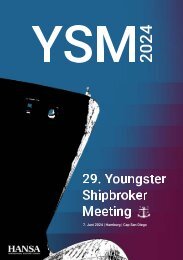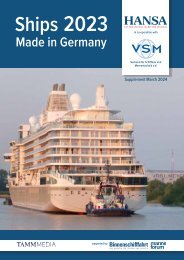HANSA 01-2021
Hull Performance & Coating · Svitzer · Yacht »Soaring« · Schifffahrtsaktien & Börsen · Harren & Partner · LNG in der Schulte-Gruppe · Berenberg Bank · Schiffsinspektionen
Hull Performance & Coating · Svitzer · Yacht »Soaring« · Schifffahrtsaktien & Börsen · Harren & Partner · LNG in der Schulte-Gruppe · Berenberg Bank · Schiffsinspektionen
Erfolgreiche ePaper selbst erstellen
Machen Sie aus Ihren PDF Publikationen ein blätterbares Flipbook mit unserer einzigartigen Google optimierten e-Paper Software.
SCHiFFStECHNiK | SHiP tECHNoloGY<br />
© data: Cklarksons<br />
LNG-fuelled/-capable Ships (excl. LNG Carriers)<br />
Segment In operation On order<br />
All 202 227<br />
Tankers 34 72<br />
Ferries 50 24<br />
Container 11 30<br />
Offshore 32 19<br />
Cruise 7 28<br />
ty for Gas as a Marine Fuel (SGMF), sees<br />
the lNG-community grow »at an accelerating<br />
pace with notable take ups in almost<br />
all sectors«. Bell says that many have<br />
changed their mind regarding lNG as a<br />
marine fuel. »The main reason is the significant<br />
and increasing availability, not<br />
of lNG but of lNG via bunkering infrastructure.<br />
This decreases uncertainties of<br />
supply and availability,« he tells HaNSa.<br />
at the same time, the main argument<br />
against lNG seems to be cost, Bell says,<br />
»not of the lNG, not necessarily the vessel<br />
either, but the infrastructure that is<br />
needed.«<br />
Nevertheless, the much-cited »chicken<br />
and egg problem« for the uptake of<br />
Green Investments Fleet % Fleet Orderbook % Orderbook<br />
Alternative Fuels Uptake, No. Vessels<br />
LNG (LNG Carriers) 407 0,4% 138 4,0%<br />
LNG (excl. LNG Carriers) 202 0,2% 227 6,7%<br />
LPG 1 0,0% 37 1,1%<br />
Biofuel 23 0,0% 7 0,2%<br />
Methanol 12 0,0% 11 0,3%<br />
Ethane 7 0,0% 13 0,4%<br />
Hydrogen 0 0,0% 3 0,1%<br />
Ammonia 0 0,0% 0 0,0%<br />
Battery / Hybrid Propulsion 141 0,1% 109 3,2%<br />
Total 776 0,8% 520 15,2%<br />
Alternative Fuels Uptake, million GT<br />
LNG (LNG Carriers) 42,7 3,0% 13,2 11,5%<br />
LNG (excl. LNG Carriers) 5,2 0,4% 15,1 13,1%<br />
LPG 0,0 0,0% 1,5 1,3%<br />
Biofuel 0,5 0,0% 0,0 0,0%<br />
Methanol 0,4 0,0% 0,3 0,3%<br />
Ethane 0,3 0,0% 0,6 0,5%<br />
Hydrogen 0,0 0,0% 0,0 0,0%<br />
Ammonia 0,0 0,0% 0,0 0,0%<br />
Battery / Hybrid Propulsion 1,0 0,1% 0,8 0,7%<br />
Total 49,9 3,5% 31,4 27,2%<br />
© Port of rotterdam<br />
lNG – especially for large, long distance<br />
deepsea vessels – has been solved<br />
by »large step changes in volumes and<br />
technology.« after smaller vessels, ferries,<br />
roro vessels and large cruise ships,<br />
CMa CGM has proven this point by introducing<br />
a new class of lNG-powered<br />
UlCVs with a capacity of 23.000 tEU.<br />
These ships have enough tank capacity<br />
for an asia-Europe roundtrip. Nine<br />
of these UlCVs have been ordered,<br />
by 2022 CMa CGM plans to operate<br />
26 lNG-fuelled ships. Hapag-lloyd is<br />
rumoured to be just about to order a dozen<br />
new lNG-powered large containerships<br />
with capacities up to 23.000 tEU.<br />
Bell points to the membrane tank technology<br />
that is needed for those vessels,<br />
which is now available. He thinks, lNG<br />
is a »natural choice for that sector on<br />
those routes«.<br />
in the recent past the market has also<br />
seen a growing number of lNG bunkering<br />
vessels (lNGBV) being delivered to<br />
operators in Europe and asia. according<br />
to SGMF’s lNGBV statistics, there is a<br />
»vertical rise in capacity«. »Many of these<br />
vessels are not solely for bunkering which<br />
is also significant and helpful,« says Bell.<br />
When the sulphur cap came into force,<br />
energy majors developed VlSFo and<br />
threw it on the market, regulations distribution<br />
and customers were already in<br />
place and were not really involved. Now,<br />
collaboration between the different actors<br />
are becoming critical for driving the uptake<br />
of lNG as a marine fuel and to take<br />
on the Co2 challenge. »Collaboration is<br />
key and there needs to be far more of it if<br />
shipping is to meet this enormous challenge«,<br />
says Mark Bell. in his view, sulphur<br />
was »the distraction for too long<br />
whilst the elephant if not the growing<br />
herd in the room was the carbon« which<br />
now demands attention.<br />
»lNG is currently and in my opinion<br />
the only compliant choice available<br />
now and in the foreseeable future that<br />
can provide a large proportion of the<br />
reductions being demanded. it cannot<br />
however provide all of it, but currently<br />
neither can anything else beyond lNG,«<br />
he adds. Waiting for »horizon fuels« and<br />
ignoring lNG will, in his view, ensure<br />
that the maritime industry fails to meet<br />
emissions targets. »lNG is a fossil fuel<br />
but methane itself is not, provision of<br />
everything around the use of lNG significantly<br />
paves the way for Bio and synthetic<br />
versions but also gas and in particular<br />
cryogenic know how for other<br />
gaseous fuels,« he says.<br />
fs<br />
HaNSa – international Maritime Journal <strong>01</strong> | <strong>2021</strong><br />
33


















